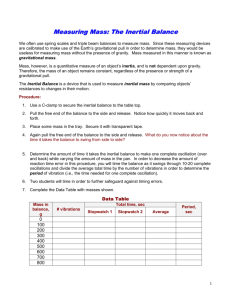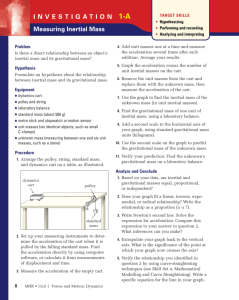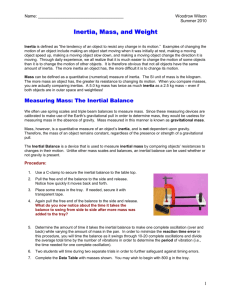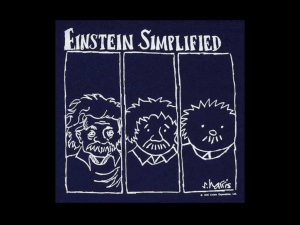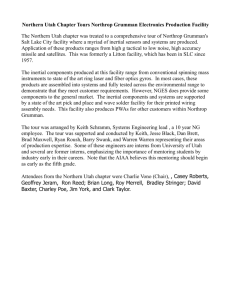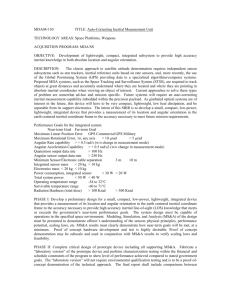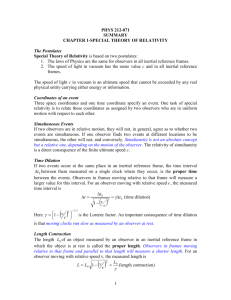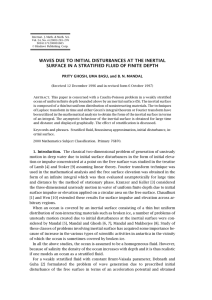Mach's Principle and an Inertial Solution to Dark Matter
advertisement
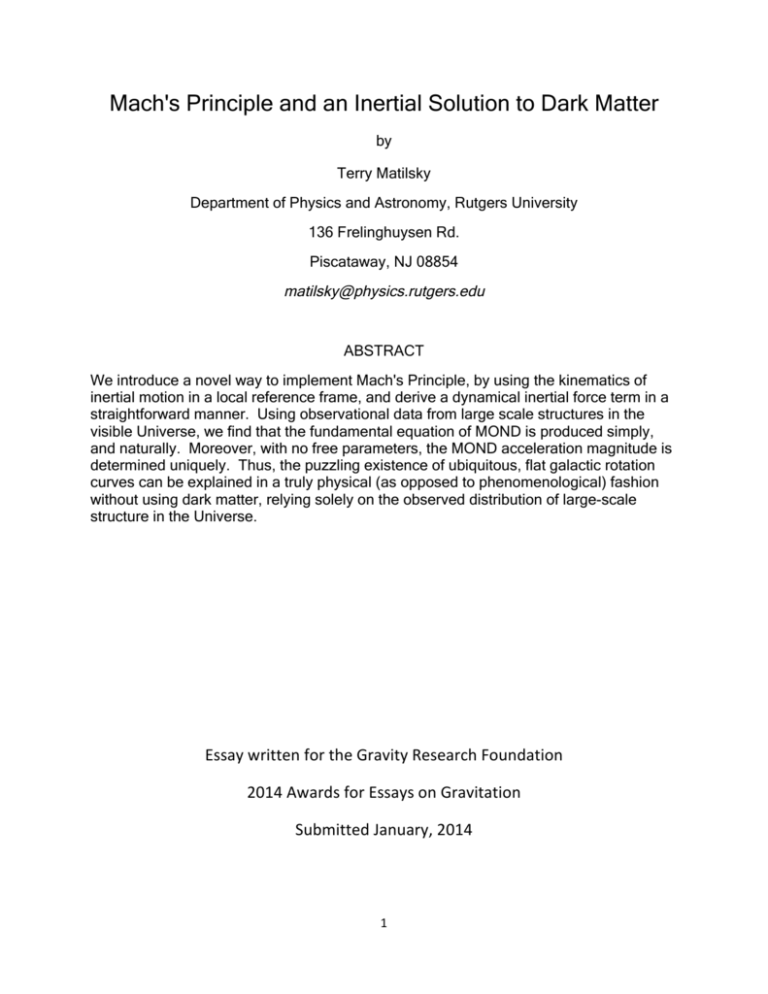
Mach's Principle and an Inertial Solution to Dark Matter by Terry Matilsky Department of Physics and Astronomy, Rutgers University 136 Frelinghuysen Rd. Piscataway, NJ 08854 matilsky@physics.rutgers.edu ABSTRACT We introduce a novel way to implement Mach's Principle, by using the kinematics of inertial motion in a local reference frame, and derive a dynamical inertial force term in a straightforward manner. Using observational data from large scale structures in the visible Universe, we find that the fundamental equation of MOND is produced simply, and naturally. Moreover, with no free parameters, the MOND acceleration magnitude is determined uniquely. Thus, the puzzling existence of ubiquitous, flat galactic rotation curves can be explained in a truly physical (as opposed to phenomenological) fashion without using dark matter, relying solely on the observed distribution of large-scale structure in the Universe. Essay written for the Gravity Research Foundation 2014 Awards for Essays on Gravitation Submitted January, 2014 1 I. KINEMATICS AND DYNAMICS USING MACH'S PRINCIPLE Few, if any, ideas in physics have generated more confusion than Mach's Principle. His notorious distrust of theory, coupled with a penchant for philosophizing in sometimes ambiguous non-mathematical terms, has resulted in hundreds of interpretations of what is even meant by the term. Zeitschrift für Physik even refused papers on the subject, because of the ubiquity of rampant polemical replies (Pais, 1982). About the only premise agreed upon is that Mach explicitly states that the motion of any test body is to be defined with respect to the rest of the entire Universe. To implement this, we visualize an idealized 2-body system, generalizing shortly to n-bodies below. Initially, we consider a 2-body system exhibiting "inertial" motion, as in Figure 1. Figure 1: Idealized inertial motion in a two body system with constant V0. We see that in polar coordinates using M1 as origin: r2 = b2 + (V0t)2 and r dr = V02 t dt, so that d2r/dt2 = 1/r [ V02 - (dr/dt)2] 1) It is quite amusing to note how coyly Mach considered this inertial velocity V0. Of course, he couldn't call it that since it would be a Newtonian reference to absolute space. Instead, he calls it "a", describing it as a "constant dependent on the directions 2 and velocities..." (Mach, 1919) thus maintaining a relativist approach. Let us pursue this further. A material point which is supposedly unaffected by external forces (such as gravity) moves in a straight line at constant speed only relative to a distinguished set of coordinate systems. Such a system cannot be assured locally, as we see above. The GR approach dictates that the way out of this conundrum is via geometry: a correct metric should accommodate any co-ordinate system, however bizarre or pathological. What is interesting in this case is that Newton's law of inertia breaks down precisely when it ought to be easiest! I.e. when ΔV = 0. Why is that? Because as soon as you use your local environment to define your coordinates (and hence V0) you introduce three inertial terms: centrifugal, transverse, and Coriolis (as can be seen easily by deriving the equation of motion for θ). However, requirements of general covariance demand that we take Eq. 1 seriously, especially if the 2 bodies are local. (We can operationally define "local" as 2 bodies that admit of a non-zero measurement of "b" in Figure 1. If b=0, the objects are sufficiently far away so that motion is purely radial, V0 → dr/dt, and our co-ordinates become "inertial".) Newton avoids this "problem" altogether by merely taking M1 and M2 as completely unrelated to each other, and taking V0 = constant as being defined by an inertial system at essentially infinity. Mach, of course, says no to this approach. The problem becomes one of constructing a formalism in which motions of bodies are influenced by each other, but in which the concept of an inertial frame is not introduced a priori. But if there is a relationship between M1 and M2, what is its dynamical nature? We note that any two masses M2 and M2' with differing distances from M1 but with identical V0 ought to be able to preserve their direction and magnitude independent of placement in space ( i.e. independent of 𝑟). Thus, if we imagine these masses at some moment in line with 𝑏 and 𝑏′ and moving with the pictured velocity V0, (i.e. co-linear at t,t'=0), dr/dt = dr'/dt' = 0. Therefore, in order to preserve the constancy of V0 in both cases, Equation 1 requires any putative dynamical force related to the masses to be proportional to 1/r. Only if 𝐹 ∝ 1/𝑟 2) can we ensure that any possible inertial "force" be universal and capable of maintaining a supposedly constant V0 , independent of position in space. (It is perhaps prudent at this point to point out that we do not have any direction defined yet, since Eq. 1 is a scalar relationship.) Interestingly, this 1/r dependence is the functional form suggested by Sciama (1953) and Ciufolini and Wheeler (1995), in their attempts to induce inertia via radiation fields. Unmodified gravity cannot fundamentally do this. Its r -2 dependence means that some function of r must remain in the kinematics. In the absence of a metrical change (which is probably inevitable for a relativistic implementation), only a dynamical force proportional to 1/r can save the phenomenon of a constant V0. Furthermore, various elementary observational requirements demand from central forces that |F| ∝ Mi mk . Now, our task is to implement a vector position. The only 3 means at our disposal to extract direction is to appeal to the equivalence principle, which at least allows us to use "G" as a universal constant, as a linkage to gravity, via minertial ♡mgrav . Thus, we can utilize GMjmk as a valid factor to extend Eq. 2. Thus, 𝐹! ∝ 𝐺𝑀! 𝑚! /r!" 3) So, if there is any hitherto unknown connection between Minertial and Mgrav, the inertial aspect must be related to gravity via direction toward distant objects, since inertia appears to be independent of local position, in the sense that V0 is arbitrary in both magnitude and orientation with respect to any and all local mass elements present in the dynamical system. In short, we appeal to classical gravity's vector nature to provide direction for our putative inertial condition. Clearly, in 2-body systems, the direction of gravitational acceleration is always unique, but when we proceed to n-body systems, complications arise. All we can say, in an arbitrary n-body system, is if we observe the local direction of gravitational acceleration (introducing a test particle at any point in spacetime), this direction will always contain, as time goes on, a component toward the source of the dominant gravitational field. In order to allow a direction to be thus defined everywhere by gravity, it is therefore reasonable to choose the maximum gravitational/inertial extent of an object as the directional determining parameter necessary to bring Eq. 3 into a dimensionally correct form. This directional extent, which we designate as ui, becomes the measure of inertial "influence" of any Mi. It determines the limiting distance beyond which the gravitational field of Mi is no longer the strongest in the system. Only if rik < ui will any test mass mk have at least a component of its motion toward Mi. For rik > ui , the mass mk will moves towards another direction determined by the position of Mj where now rjk < uj , and which thus determines the source (and direction) of the dominant gravitational/inertial mass acceleration. Therefore, the proposed force in Equation 3 becomes: 𝐺 𝑀 𝑚 𝐹! = − 𝑢 𝑖 ∗ 𝑟 𝑘 𝑖 𝑖𝑘 (if attractive) 4) The existence of ui for any system of Mi merely implies the fact that an equilibrium value of the center of mass between any two objects can be found. In a sense, ui defines a Lagrange point for inertial interactions. But, there is absolutely no reason a priori to expect that these values will have any functional significance. For example, in a uniformly populated distribution of stars of equal mass, ui will be invariant and equal to about half the interstellar spacing of the distribution. To take another example, we imagine the 3 body system pictured in Figure 2. 4 Figure 2. Showing changes in ui for two different simple distributions of 3 masses. This schematic diagram clearly indicates the fact that we can alter the magnitude of ui significantly and apparently at will, simply by altering the relative positions of the Mi . Any systematic distribution of ui and hence Mi in the Universe would be truly surprising. II. LARGE SCALE STRUCTURE AND MOND One of the more remarkable (yet seemingly trivial) property of the Universe is that it doesn't consist of a uniform sprinkling of individual masses. For example, long before we get to the half-way point from the Sun to, say, α Centauri (which we might naively assume to approximate usun), we encounter the dominant field of the Milky Way itself. Beyond the u value quoted below for the Milky Way, to take yet another example, the Virgo cluster becomes the dominant gravitational source rather than M31. For extended systems, such as globular clusters, galaxies, etc., we can approximate ui by the observed physical size of the object itself. In this fashion, u becomes a tidal radius. For systems like the Sun, of course, we need to resort to the maximum influence distance as elucidated above. The results are shown in Table 1 and Figure 3 below: 5 M u M/u Sun: 2 x 1033 g 8 x 1016 cm 2.5 x 1016 g/cm Globular clusters: 2 x 1038 g 5 x 1019 cm 4 x 1018 g/cm Dwarf Spheroidals: 2 x 1041 g 2 x 1021 cm 1 x 1020 g/cm Milky Way: 2 x 1044 g 1 x 1023 cm 2 x 1021 g/cm Coma Cluster: 6 x 1047 g 1 x 1025 cm 6 x 1022 g/cm Notes: value for dSph is the tidal radius, GC's use r=0.9 total light, Coma mass is x-­‐ray gas mass, with r= 3 Mpc (isothermal sphere value), Milky Way shows radius of the globular cluster system ~30 kpc, Sun uses distance at which Sun's gravitational field equals that of the Milky Way. Table 1: All values of mass and size are taken from Carroll and Ostlie (2006). Moreover, only luminous masses are quoted. Figure 3: The resulting plot of values shown in Table 1. Errors shown are purely formal, and merely represent order of magnitude uncertainties in the quoted values. 6 Quite astonishingly, we see that "u" in Eq. 4 can now be transformed away, since M/u ∝ √M Thus, √M/u becomes a universal invariant independent of mass. Even more remarkable is the quantitative value that this transformation yields: ! !! ! !! |𝑎! | = ∙ ! !!! ! !! ! = ∙ 𝑘! 𝑀! = 𝐺 ∙ 𝑘! ∙ = 𝑎! ∙ 𝑎! 5) where R now replaces rik as the distance between the test particle and the most dominant source of gravity locally. This is the exact functional form of MOND (Milgrom, 1983a), where aN is the Newtonian acceleration, and a0 = G ∙ 𝑘!! ≈ 6 ∙ 10!! 𝑐𝑚/𝑠 ! , quite close to the value chosen purely phenomenologically by Milgrom (1983b). Note that at R = ui , |𝑎! | = G Mi / ui2 = G k42 = a0 , independent of M. 5a) Thus, using an explicitly Machian analysis of large scale structure throughout the Universe, we can for the first time place MOND on a firm dynamically empirical basis. Therefore, dark matter may be unnecessary to explain (for example) the ubiquitous, flat galactic rotation curves that have puzzled astrophysicists for over half a century. References Carroll, B. & Ostlie,D., 2006, An Introduction to Modern Astrophysics, 2nd. Ed. , (Addison-Wesley, NY) Ciufolini, I. & Wheeler, J. A., 1995, Gravitation and Inertia, (Princeton University Press, Princeton) Mach, E., 1919, The Science of Mechanics, (Open Court Publishing, London), p. 234 Milgrom, M., 1983a, Ap. J. 270, 384 Milgrom, M., 1983b, Ap. J. 270, 365 Pais, A., 1982, Subtle is the Lord...,(Oxford University Press, Oxford), p. 288 Sciama, D. W., 1953, MNRAS 113, 34 7
